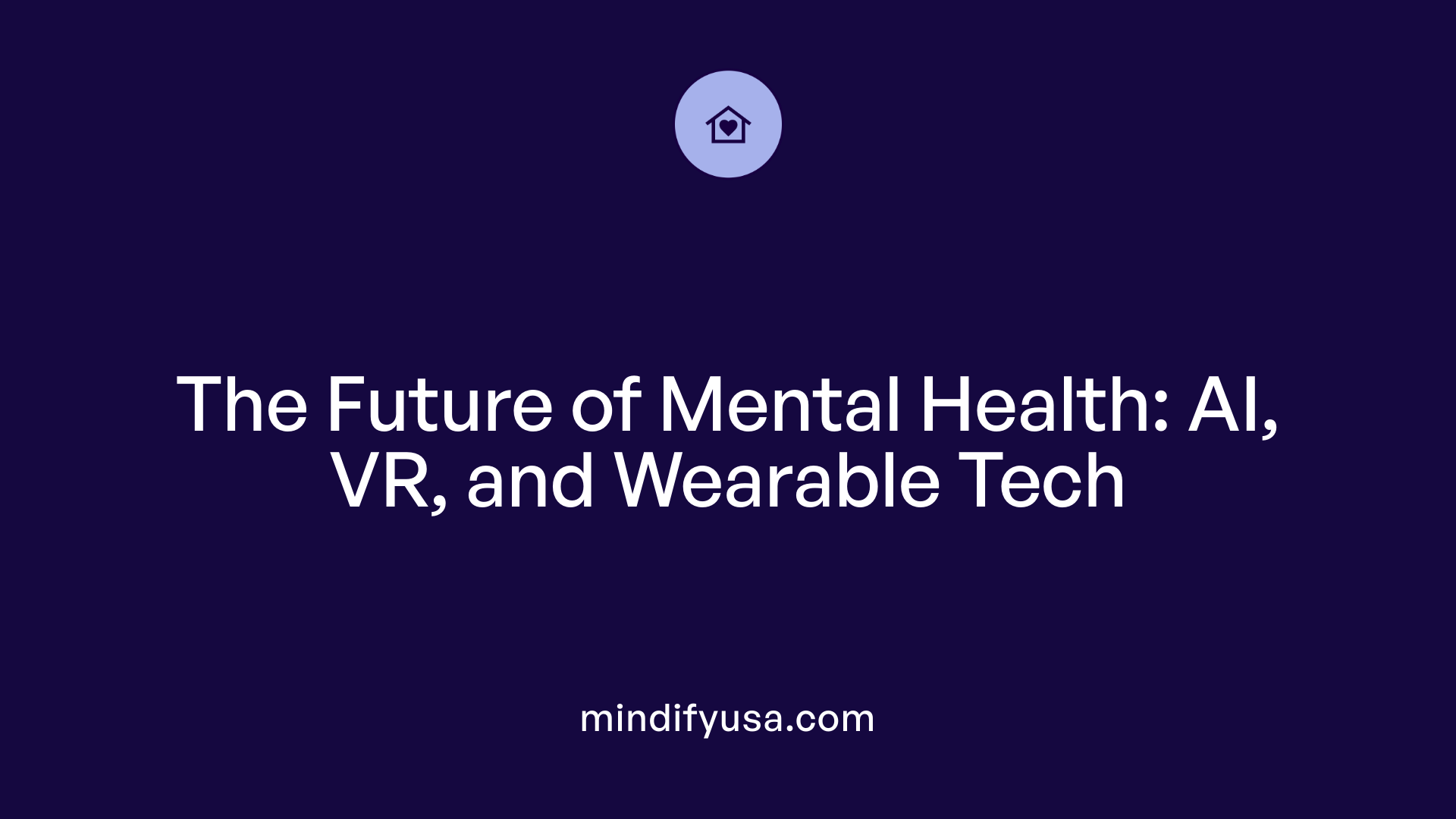Expanding Reach and Enhancing Care through Innovation
The landscape of mental health care is undergoing a profound transformation driven by advanced digital technologies. From telehealth platforms to AI-driven diagnostics, these innovations are breaking down traditional barriers and creating new pathways for support. This article explores how technology is reshaping access to mental healthcare, enhancing personalization, and addressing longstanding challenges—paving the way toward more inclusive, efficient, and effective mental health services.
Digital Technologies Expanding Access to Mental Healthcare

What are the ways technology is transforming mental healthcare access?
Technology has revolutionized mental health care by enhancing accessibility, convenience, and customization. Telehealth platforms and virtual care—such as video conferencing services—have become primary channels for delivering therapy and psychiatric consultations. These tools remove geographical barriers, enabling individuals in rural or underserved areas to connect with licensed professionals without the need for travel, thus reducing waiting times and increasing treatment adherence.
Mobile apps designed for mental health support provide users with tools like mood tracking, guided meditation, and self-help modules. Apps such as Headspace, Calm, and Moodpath offer immediate access to wellness resources at any time, often at a lower cost than traditional therapy. Many of these apps also incorporate cognitive behavioral therapy (CBT) principles and support peer communities, making mental health management proactive and less stigmatized.
Remote monitoring using sensors and wearable devices has emerged as a valuable component of a comprehensive care strategy. Devices like smartwatches and fitness trackers track physiological markers such as heart rate variability, sleep patterns, and stress levels. Continuous data collection allows for early detection of mood shifts or anxiety episodes, facilitating timely intervention by clinicians or automated alerts from digital platforms.
Connecting these innovations is robust digital health infrastructure supported by policy initiatives and cloud-based systems. Organizations like NHS in England and Healthdirect Australia leverage digital front doors to streamline access, providing unified portals for health information and services, including mental health resources. These systems enable smoother user experiences and data sharing among providers, promoting coordinated care.
The COVID-19 pandemic accelerated the adoption and normalization of digital modalities, emphasizing the importance of flexible, remote mental health services. AI-driven tools such as chatbots (Woebot, Wysa, Talkspace) deliver 24/7 support, provide psychoeducation, and assist early diagnosis through analysis of speech, text, facial expressions, and behavioral patterns.
Despite these advances, challenges persist. Issues like ensuring app quality, safeguarding data privacy, addressing the digital literacy gap, and designing user-centered interfaces are critical for equitable and effective deployment. As the landscape evolves, ongoing research and regulation aim to standardize digital mental health tools, ensuring they are safe, reliable, and accessible to all demographics.
| Technology Type | Main Function | Impact Area | Additional Details |
|---|---|---|---|
| Telehealth platforms | Remote therapy and psychiatric care | Increased access, reduced travel | Facilitates video, audio, and text-based sessions; |
supports rural and underserved populations || Mobile Apps | Self-management, mood tracking, mindfulness | Continuous engagement, early intervention | Offers structured programs, on-demand support, uses AI for personalized suggestions | | Wearable sensors | Physiological data collection | Early detection, relapse prevention | Examples include heart rate variability, sleep metrics | | Digital infrastructure | Streamlined access, data sharing | Improved coordination of care | Cloud-based portals like NHS login, Healthdirect Australia | | AI-powered tools | Early diagnosis, virtual assistants | Personalized care, administrative support | Chatbots offering CBT, predictive models for risk assessment |
In summary, the integration of telehealth, mobile applications, sensors, and robust digital infrastructure has expanded the reach and quality of mental health services. These innovations enhance early detection, foster ongoing engagement, and enable personalized treatment, setting the stage for a more accessible, efficient, and responsive mental healthcare system.
AI and Digital Tools Facilitating Early Detection and Personalized Care

How does technology influence the personalization of mental health support?
Technology significantly transforms how mental health care is tailored to individual needs. Artificial intelligence (AI), data analytics, and innovative digital tools enable clinicians and support systems to create highly customized treatment plans.
One of the main ways technology achieves this is through AI-driven applications like virtual therapists and chatbots such as Woebot, Wysa, and Talkspace. These tools analyze speech patterns, facial expressions, and behavioral cues to identify early signs of mental health issues. By continuously monitoring user interactions and biometric data collected via sensors and smartphones, these systems can detect changes that might indicate a potential crisis or worsening condition.
Digital phenotyping—a method involving real-time data collection from wearables and mobile devices—provides valuable insights into an individual’s mental state. Metrics like heart rate variability, sleep patterns, physical activity, and even social media activity contribute to building a detailed behavioral profile. This allows for timely and precise adjustments to treatment strategies.
Predictive analytics complement these efforts by evaluating multifactorial data, including genetics and environmental influences, to forecast disease progression and risk. Such insights support the development of personalized intervention strategies, making treatment more effective and responsive.
Virtual reality (VR) therapies and generative AI techniques further enhance personalization by enabling customized exposure scenarios and ongoing support tailored to each patient's specific challenges. For example, VR modules can simulate social situations or phobic stimuli, allowing for immersive, targeted interventions.
Accessibility and inclusivity are central to these advancements. Features like multilingual support, adaptable interfaces, and culturally sensitive content ensure that personalized care reaches diverse populations.
While these technological advancements enable scalable, individualized, and proactive mental health support, they demand strict attention to ethical issues such as data privacy, bias reduction, and the importance of human oversight. Ensuring these tools are used responsibly guarantees they complement traditional mental health services effectively.
Innovative Therapeutic Modalities Using Virtual Reality and AI
What are some current technological applications in mental health services?
Technology has significantly transformed mental health care, offering a diverse array of digital interventions and applications. Among these, virtual reality (VR) is used to create immersive environments that assist in treating anxiety disorders, PTSD, and specific phobias. VR-based exposure therapy allows patients to confront feared stimuli in a controlled, safe setting, often resulting in better outcomes than traditional methods.
Artificial intelligence (AI) plays a growing role as well. Large language models and chatbots like Woebot and Wysa deliver evidence-based therapeutic techniques, such as cognitive-behavioral therapy (CBT), around the clock. AI-driven content generates realistic scenarios and simulations to help users develop coping skills, manage symptoms, and even prepare for stressful situations.
Immersive experiences are being used for emotional processing by simulating scenarios that help individuals confront and work through difficult emotions safely. These experiences can be tailored to the needs of the user, making therapy sessions more engaging and personalized.
In addition to VR and AI, mixed reality applications integrate both virtual and real-world elements to enhance mental health treatments. For example, clinicians may employ mixed reality environments for social skills training or emotional regulation exercises, providing a flexible and immersive approach.
Current innovations also include passive sensor-based data collection via smartphones and wearables, which monitor physiological responses and behavioral patterns in real time. These insights allow for personalized interventions and early detection of symptom escalation.
The combination of these technologies offers promising avenues for expanding access, increasing engagement, and improving treatment effectiveness for a range of mental health conditions. As research advances, future applications will likely become more sophisticated, integrating AI, virtual and mixed reality, and real-world data to create comprehensive, personalized care pathways.
| Application Area | Description | Examples |
|---|---|---|
| Exposure Therapy | Using VR environments to simulate feared stimuli for safe confrontation | VR scenarios for phobias, PTSD, anxiety |
| AI-Generated Content and Simulations | Creating realistic, personalized therapeutic interactions using AI | Chatbots, virtual scenarios, psychoeducation |
| Emotional Processing | Facilitating emotional work through immersive experiences | VR emotional regulation tools |
| Mixed Reality Applications | Combining virtual and real-world elements for therapy | Social skills, stress management, trauma recovery |
| Passive Data Collection | Monitoring physiological and behavioral responses via wearables and sensors | Mood, sleep, activity tracking |
These innovative modalities exemplify how modern technology is reshaping mental health treatment, making interventions more accessible, engaging, and tailored to individual needs.
Impact of Heavy Technology Use on Mental Wellbeing
What is the impact of heavy technology use on mental health?
Heavy engagement with digital devices, especially social media platforms, has been associated with a range of mental health challenges. Increased use often correlates with higher levels of anxiety, depression, and feelings of social isolation. These effects are frequently driven by social comparison, where individuals compare their lives to curated images and experiences shared online, leading to dissatisfaction and lowered self-esteem.
Cyberbullying also plays a significant role, exposing users to harmful interactions that can cause emotional distress. Additionally, excessive screen time, particularly before bed, interferes with sleep quality due to the blue light emitted by devices. Poor sleep not only affects overall well-being but also heightens vulnerability to mood disorders such as depression and anxiety.
Despite these risks, technology also offers substantial benefits for mental health. Online communities provide social support, and telehealth platforms enable access to therapy and mental health resources regardless of geographical location. Apps that promote mindfulness, mood tracking, and stress management serve as valuable tools for managing mental health.
The effects of heavy technology use on mental well-being are highly dependent on individual patterns of use. Mindful engagement, setting healthy boundaries, and being aware of usage habits can help mitigate negative outcomes.
Overall, the relationship between technology use and mental health is complex and influenced by factors such as personal vulnerability, usage context, and the intention behind technology engagement. Promoting balanced, conscious use is essential to harness the benefits of digital tools while minimizing their risks.
Ethical Considerations and Data-Driven Approaches in Digital Mental Health

What ethical considerations and data-driven approaches are involved in digital mental health?
Digital mental health technologies are transforming how care is delivered by harnessing tools like artificial intelligence (AI), big data analytics, wearable sensors, and real-time monitoring systems. These innovations enable personalized treatment plans, early prediction of mental health crises, and broader access to support, especially for underserved populations.
However, the integration of advanced technologies brings various ethical challenges. Key among these are issues related to data privacy, security, and consent. Patients' sensitive information—ranging from speech patterns and facial expressions to biometric data and social media activity—must be protected from misuse or breaches. Ensuring robust data security measures is paramount to maintain trust and compliance with legal standards.
Bias and fairness in AI algorithms are other significant concerns. If not properly designed and validated, AI tools risk perpetuating existing disparities, discriminating against certain groups based on race, ethnicity, socioeconomic status, or other factors. Developers and clinicians must actively work to identify and mitigate biases, ensuring that digital interventions serve all populations equitably.
Stakeholder perspectives illustrate differing ethical priorities. Consumers often view ethics as focused on privacy and confidentiality, emphasizing control over their personal data. Healthcare providers, meanwhile, prioritize competence, responsibility, and ensuring that AI tools enhance clinical decision-making without replacing human judgment.
Transparency and regulation of AI tools are critical for safeguarding ethical standards. Clear guidelines, validation protocols, and oversight mechanisms can help ensure that digital health interventions are safe, effective, and accountable. Without regulation, there's a risk of unvetted tools disseminating misinformation or offering unproven treatments.
Another pressing issue is the commodification of health data. As digital tools collect extensive behavioral and psychological data, concerns arise about data being sold or used for commercial gains beyond the scope of patient care. Such practices can erode trust and compromise patient rights.
Moreover, the proliferation of mental health misinformation online can harm individuals relying on unverified or misleading content. Regulatory efforts and educational initiatives are necessary to promote accurate information and prevent adverse outcomes.
Balancing innovation with ethical integrity requires stakeholder-centered policies that prioritize user autonomy, privacy, and equity. Developing standards for validation and an ethical framework for AI deployment ensures that technological advances serve the well-being of all users.
In conclusion, the future of digital mental health hinges on integrating cutting-edge data-driven approaches with rigorous ethical safeguards. Thoughtful policy-making, transparency, and active stakeholder engagement are vital to harness the potential of technology while Upkeeping trust, safety, and fairness in mental health care.
The Role of Policy, Regulation, and Stakeholder Engagement
What regulatory frameworks and standards are in place for digital mental health tools?
Currently, the digital mental health landscape is characterized by rapid innovation, but it faces challenges regarding regulation and standardization. Unlike traditional healthcare, which is heavily regulated with clear standards, many mental health apps and AI tools operate in a relatively unregulated environment. Presently, there are no universally accepted standards specifically governing the efficacy or safety of most mental health apps.
However, some digital therapeutics, like certain FDA-approved apps, do meet strict clinical and safety standards, providing models for future regulation. Governments and regulatory agencies worldwide, such as the US Food and Drug Administration (FDA), European Medicines Agency (EMA), and others, are increasingly developing frameworks to evaluate digital health devices, including digital therapeutics, biomarker-based apps, and AI-driven tools.
These efforts include establishing evidence standards, quality assurance measures, and safety protocols to ensure digital tools are effective, safe, and ethically sound. The development of these standards aims to foster innovation while protecting users from unvalidated or potentially harmful interventions.
How are stakeholders—including users and providers—engaged in shaping digital mental health policy?
Effective regulation and development of digital mental health solutions require collective input from diverse stakeholders. Users, including patients and caregivers, provide essential insights into usability, privacy concerns, and cultural relevance.
Providers, mental health clinicians, and researchers contribute expertise on clinical efficacy, practical application, and safety. Policymakers and regulators work to craft policies that balance innovation with protection.
Collaborative approaches involve direct engagement through public consultations, advisory panels, and user-centered design processes. For example, stakeholder involvement is crucial in identifying salient ethical issues, ensuring accessibility, and addressing disparities.
Organizations such as research institutions, professional bodies, patient advocacy groups, and industry stakeholders are increasingly adopting participatory models to co-create standards, guidelines, and policy frameworks that are responsive and responsible.
What are living labs and how do they support iterative testing of digital mental health tools?
Living labs are real-world environments where digital health solutions are tested and refined through iterative cycles involving end-users, clinicians, and developers. They foster a collaborative space for experimentation, feedback, and co-design.
In the context of digital mental health, living labs enable continuous evaluation of new apps, AI algorithms, and interventions in settings that mimic everyday use. This process helps identify usability issues, safety concerns, and effectiveness early on.
By integrating user feedback and clinical insights, living labs facilitate adaptive development, leading to more user-friendly, trustworthy, and scalable solutions. They are regarded as vital for establishing evidence, fostering trust, and accelerating deployment.
What policy initiatives are currently supporting the expansion of digital mental health services?
Recognizing the potential of digital health, many governments and organizations have launched initiatives to promote digital mental health. These include funding research on digital interventions, creating reimbursement models for telehealth services, and establishing national guidelines.
For instance, recent policies in various regions now include reimbursement codes for digital therapeutics, support for telehealth access, and investment in digital health infrastructure. The Centers for Medicare & Medicaid Services (CMS) in the US, for example, has approved new reimbursement codes for FDA-cleared digital mental health therapies.
In addition, initiatives like the NIH All of Us Research Program and BRAIN Initiative aim to generate data and develop tools that improve mental health treatment through digital innovations.
How are ethical considerations and data management addressed in digital mental health?
Digital mental health involves numerous ethical issues centered on respecting patient rights, privacy, and data security. A significant concern is ensuring user data is protected against breaches, misuse, or unintended disclosure.
Stakeholders highlight the importance of transparency in data collection and use, fair AI algorithms free from bias, and maintaining user autonomy.
Data-driven approaches utilize technologies such as AI, real-time monitoring, and digital phenotyping to personalize interventions. These methods necessitate stringent validation, regulatory oversight, and safeguards against discrimination or misinformation.
Efforts are also ongoing to develop standards that uphold ethical principles, including consent, confidentiality, and equitable access. Addressing these issues is crucial for building trust and ensuring the responsible deployment of digital mental health technologies.
This comprehensive framework of policy, stakeholder engagement, and ethical oversight ensures that digital mental health tools are safe, effective, and aligned with societal values. It also helps in addressing disparities, promoting inclusivity, and fostering innovation that benefits everyone.
| Aspect | Description | Importance |
|---|---|---|
| Regulatory Standards | Development of evidence-based safety and efficacy protocols; FDA approvals | Ensures user safety and product reliability |
| Stakeholder Involvement | Engagement of users, clinicians, policymakers in policy shaping | Facilitates relevant, usable, and accepted tools |
| Living Labs | Real-world testing environments with iterative feedback | Accelerates innovation and trust |
| Policy Initiatives | Funding, reimbursement, guidelines supporting digital health | Promotes adoption and scalability |
| Ethical and Data Management | Privacy, bias mitigation, transparency | Maintains trust and safeguards rights |
Understanding and integrating these elements are vital for advancing digital mental health responsibly and effectively.
Future Prospects and Emerging Technologies in Mental Healthcare

What is the future outlook for mental health technology?
The future of mental health technology appears highly optimistic, driven by rapid innovations in artificial intelligence (AI), virtual reality (VR), wearable devices, and digital therapeutics. These emerging tools are expected to transform traditional mental health care by making interventions more personalized, scalable, and accessible.
AI developments are enabling early detection of mental health issues through analysis of speech, facial expressions, social media activity, and physiological data. This capability allows for proactive, just-in-time interventions tailored to individual needs. Virtual reality offers immersive therapy environments for conditions like PTSD, phobias, and anxiety, providing engaging treatment options that complement or even enhance conventional approaches.
Wearable technology, such as smartwatches and biosensors, continuously monitors physiological metrics like heart rate variability, sleep, and stress levels. When integrated with AI, these devices can identify early warning signs of relapse or deterioration, enabling timely clinical responses.
The integration of digital tools into routine care is on the rise. Telehealth platforms and mobile apps now expand care reach, especially in remote or underserved areas. These tools support not only formal therapy but also promote self-management through mindfulness exercises, mood tracking, and psychoeducation, reducing stigma and increasing engagement.
Advances in personalized and precision mental health are evident through AI-driven treatment planning that considers genetic, behavioral, and environmental factors. This tailored approach aims to improve treatment efficacy and minimize side effects.
Ongoing research and development are coupled with regulatory advancements, such as FDA approvals for digital therapeutics like SleepioRx and DaylightRx. These developments ensure safety and efficacy, encouraging broader adoption.
Furthermore, digital phenotyping—continuous behavioral data collection via smartphones—provides real-time insights into an individual’s mental health, enabling early intervention before crises occur. Data platforms and predictive analytics are becoming vital tools for clinicians, offering a more dynamic and responsive care environment.
As investment and innovation continue, digital mental health technologies are expected to become foundational elements of comprehensive mental health systems worldwide. They promise a future where mental healthcare is more proactive, personalized, and integrated, ultimately improving outcomes and expanding access for diverse populations.
A New Era in Mental Healthcare
As technology continues to evolve at a rapid pace, it holds the promise of transforming mental healthcare into a more accessible, personalized, and effective field. While challenges around ethics, privacy, and equity remain critical, ongoing innovation, coupled with stakeholder engagement and sound regulation, can ensure these tools serve as powerful complements to human care. The integration of AI, virtual reality, wearables, and telehealth heralds a future where mental health support is no longer confined by physical, geographical, or societal barriers but becomes a truly inclusive global endeavor, enhancing well-being for all.
References
- Technology and the Future of Mental Health Treatment
- Enhancing mental health with Artificial Intelligence: Current trends ...
- How Technology is Transforming Mental Health Care - Lehigh Center
- Technology is Key to Improved Mental Health in the Future
- The evolving field of digital mental health: current evidence and ...
- Revolutionizing Behavioral Health Through Technology and AI
- Can Mental Health Care Become More Human by Becoming More ...
- Digital transformation of mental health services - Nature
- The role of technology in improving access to mental health care
- How AI could expand and improve access to mental health treatment






































































































